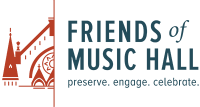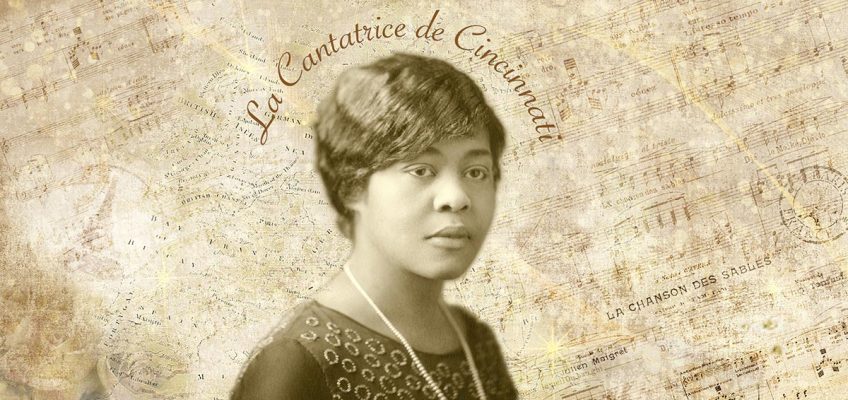![]()
By Thea Tjepkema
There are singers whose names are legends and whose artistry will never be forgotten. There are others of exceptional talent who also made remarkable contributions to the musical world, but whose stories of perseverance may soon evaporate over time. Nadine Roberts Waters was such a singer.
they will hear my song and the glory shall be for my people,
Not since the 1893 visit of famous operatic soprano Sissieretta Jones had there been a solo performance by an African American classical concert singer in the Springer Auditorium. By her 1928 debut, Nadine Roberts Waters had already completed six years at the New England Conservatory of Music-NEC in Boston and would head to Paris in 1929 for another six years to perform and study alongside the esteemed teacher, Nadia Boulanger, and composer, Albert Roussel, and other great musicians of the 1930s.
After her prodigious international career, Waters returned one more time to perform in Music Hall in 1954 and sang for a benefit concert for the Negro Sightless Society of Ohio*. No programs or reviews have been unearthed for either of her Music Hall performances, but we can conclude she achieved success based on her additional performances over 60 years in Boston, New York, Paris, as well as venues across Cincinnati. Her voice was described as that of a nightingale, with pure sweetness, flexibility, and strength. She maintained exquisite diction in a half-a-dozen languages in a broad range of classical works and spirituals.
At Home and Church in Wyoming, Ohio
Ella Nadine Roberts was born at home on February 16, 1892, and grew up in Wyoming, Ohio, in a musical family. She said her father purchased their house in Glendale and had it dismantled piece by piece and rebuilt in Wyoming and that she attended Wyoming Public Schools.

Photo by Matthew Zory
Her love of music first developed while singing in the Maple Street Christian Church at 620 Maple Street, established in 1871 in neighboring Lockland. The church she attended and still stands was constructed in 1888 and built with funding from her grandparents. Her sisters, Cora and Edythe, sang with her in the church choir. Sometimes Edythe also accompanied Nadine on the piano for recitals. Their mother, Ella Taylor Roberts, was a teacher at the Oak Avenue School and organist and choir director of the Maple Street Church for over 35 years. Their father, Martin Van Roberts, was a bass singer in the church choir and was the first Black supervisor of the U.S. Postal Service in Cincinnati. He lived in Wyoming for 70 years.
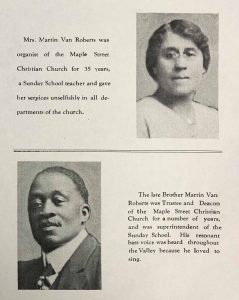
NRW Scrapbook, Wyoming Historical Society
The Roberts house was built at 627 Vine Street in Wyoming, but the street name was changed to Van Roberts Place in honor of Nadine’s father in 1981 by a petition of loving neighbors and unanimously passed by the City Council on the first of November that year. Mr. and Mrs. Roberts were well known in the community, members of several charitable institutions, and musically active. In an interview by The Cincinnati Enquirer after the street name change, Nadine described how her father had “organized a youth band to keep boys off the streets.” Nadine lived in the house until she died at 93½ years old on September 8, 1985.
Nadine Roberts married widower Frank C. Waters, a print shop engraver, on April 19, 1915, and they moved into a home a block away from her parents. (They later divorced in 1938.) The couple adopted a daughter, Inez Vivian, within a few years. She was listed as 4 years old in the 1920 census; sadly, she died at a young age around 1924.
The Waters name frequently appeared in The Union, Cincinnati’s Black newspaper: singing at weddings and recitals in local churches; following her singing career in Boston, New York, and abroad; fundraising for a YWCA building on Eighth and Cutter streets; and mentioning notable visitors to their home.
In September 1926, the Waters entertained Noble Sissle, a famous jazz composer, lyricist, and bandleader known for the Broadway musical Shuffle Along and its hit song “I’m Just Wild About Harry.” Sissle’s visit to Mr. and Mrs. Frank Waters’ home was listed under an announcement that Nadine Roberts Waters would sing on WLW’s “Who’s Who in Radio in Ohio” thanks to her frequent performances and popularity. She sang regularly on WLW in Cincinnati throughout her career, as well as WNAC and WLOE in Boston, and WNYC in New York City.
Boston and Back: Memorial Hall Recitals with Fellow NEC Musicians
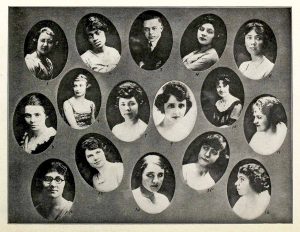
Neume Yearbook, Bernice Annette Bonner (#2.)
In the ’20s Nadine changed the spelling of her name to Nadyne and began regularly traveling back and forth between Cincinnati and Boston to complete a total of 13 semesters of classes at NEC, from 1922 to 1929 (except for 1928). While studying in Boston she gave numerous recitals, including an occasional appearance of ‘little Inez’ accompanying her as an elocutionist.
At home in the summer of 1923, July 5, Waters gave a concert in the Hamilton County Memorial Hall, presented by the Kenyon Avenue Christian Church. In Memorial Hall, downtown Cincinnati, she sang alongside a fellow African American NEC student, violinist Abram McClenney, from St. Louis, and Helen Greer, a local pianist who studied at the Cincinnati Cosmopolitan School of Music, and music teacher at the Harriet Beecher Stowe School. The recital was repeated on July 19, at the Wyoming YMCA on Wayne Avenue. The review in The Union, declared the enthusiastic audience found Water’s personality, “winsome and charming… her voice fresh and free… (the recital) was very, very successful… and several bouquets were presented.” Another Bostonian pianist, Orchiea G.G. Johnson accompanied Waters in Memorial Hall, on a Thursday, September 24, 1925.
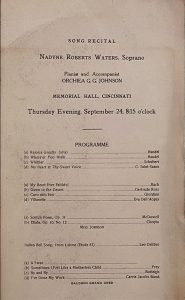
Wyoming Historical Society
The printed program preserved in her scrapbook of the second recital in Memorial Hall, reveals Waters’ programming style, beginning with several classical selections, then an interlude of two pieces on piano, and concluding with spirituals. The 1925 performance included spirituals arranged by white pianist and composer Hugo Frey, and African American composer and professional singer Harry T. Burleigh, who brought classical arrangements of spirituals to the concert stage. The recital ended with a popular song by Carrie Jacobs Bond, I’ve Done the Work. Bond was the first woman to sell over a million copies of her piece I Love You Truly. Another African American NEC musician (1920 graduate) and Bostonian, Bernice A. Bonner pianist, and Abram McClenney, violinist, would perform with Waters singing in the summer of 1927 again at Memorial Hall, next door to Cincinnati Music Hall.
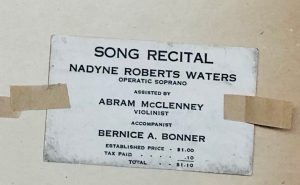
Wyoming Historical Society
Cincinnati Music Hall Debut in 1928

In 1928, Nadine Roberts Waters debuted in Cincinnati’s largest concert venue, Springer Auditorium (3,526 seats), during the Cincinnati Music Hall Golden Jubilee and Greater Cincinnati Industrial Exposition (Oct. 3-14) to celebrate the 50th anniversary of the building’s opening and remodel of the north and south wings. The Enquirer advertised the Jubilee would host many businesses in industrial exhibits, military displays in the North Hall, and Cincinnati Public School booths in the South Hall, and daily entertainment in Springer Auditorium, on the main stage, featuring the greatest talent in Cincinnati. On the schedule for Friday evening, Nadine Roberts Waters was heralded in the Enquirer as the “most celebrated dramatic soprano of her race with a national reputation.” Friday, October 5, the third day of the 11-day celebration was “Stephen Foster Day” preceding “Kentucky Day” on Saturday. Friday afternoon 1,000 public school children, including the Stowe School, under the direction of Walter H. Aiken, sang Foster’s songs.
Afterward, Cincinnati and Northern Kentucky mayors gave speeches about composer Stephen Foster’s contributions to American music, especially while living in Cincinnati. A bronze bust of Foster was unveiled on the stage by Marian Foster Welch, the 77-year-old daughter of the composer. The Cincinnati Post observed, “Tho she had heard her father sing his songs many times, Mrs. Welch wept as My Old Kentucky Home, Old Black Joe, and Swanee River,” were sung by the school chorus. That evening alumni students from the North Fairmount Public School, under the auspices of the Cincinnati Civic Theater, presented a play written by principal Essie Arey, based on Foster’s life. The Enquirer announced that Nadine Roberts Waters would sing My Old Kentucky Home and spirituals.
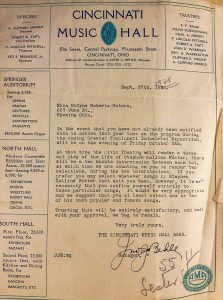
A letter, saved in Waters’ scrapbook, now in the Wyoming Historical Society, was sent from the Music Hall manager, John J. Behle cordially inviting Nadine to sing between the three-act play, during the two ten-minute intermissions. Behle wrote to Waters, “…we are counting on you to render two selections… If you prefer you may select whatever songs by Stephen Collins Foster that suit you best, however, it is not necessary that you confine yourself strictly to these particular songs. It would be very appropriate, and we suggest that you at least select one or two of his most popular and famous songs.” Later the newspaper announced she would sing, My Old Kentucky Home, and spirituals, which would have filled the remaining allotted time. Waters’ solo performance, especially to sing spirituals, was emblematic of her struggle, as a Black woman, to break into the white classical music establishment.
Lillian Aldrich Thayer Settlement School of Music

Cincinnati Music Hall
The Music Hall Jubilee entertainment program calendar in the Enquirer listed Waters with the St. Andrew’s Episcopal Church branch under the direction of Lillian Aldrich Thayer. The Thayer Settlement School of Music** was established by Lillian Aldrich Thayer for students unable to afford regular training. Thayer taught voice and was on the faculty of the Cincinnati Conservatory of Music. She would write a recommendation letter for Nadine Waters, describing how she was, “impressed by her work and lyric tones,” and would happily testify to her, “impressions of Mrs. Waters voice and style.” When Waters performed in Music Hall, she was already classically trained in voice, languages, diction, and acting, locally at Thayer’s Settlement School of Music and the New England Conservatory. At NEC she studied voice for 12 semesters with celebrated tenor, Clarence B. Shirley. Starting in 1926 she took additional courses in languages: Italian and German diction, and French conversation, as well as a class in solfège.
The Valley Forge Club
The next month, November 23, 1928, after her Music Hall debut, Waters performed for the fourth time in Memorial Hall under the auspices of the Valley Forge Club. The Valley Forge Club was established in 1912 by a group of African American women to help improve the lives of Black Cincinnatians. They would become a federated club and award scholarships into the late 1970s. The review in the Enquirer recognized Waters, “has had the advantage of competent guidance, and in her manner of musical expression, interpretive talent and judgment in program building prove that the realm of art knows no race distinction,” and she sang, “three arias by Parelli, Rossini, and Debussy, (as well as) Schubert and Brahms …(and) negro folk songs were fittingly made part of the program, forming the final group.” The reviewer also notes she sang in four languages and, “a good-sized audience enjoyed the singing.” She was accompanied again by Boston pianist, Orchiea G.G. Johnson.
Charlotte R. Schmidlapp Scholarship and Raising Funds
When Nadine returned home in the summer of 1927 to sing in Memorial Hall and Cincinnati Music Hall in 1928, she was preparing for the next step in her career. She applied to the Charlotte R. Schmidlapp Fund for a loan, which was often referred to as a scholarship since there was no obligation to pay it back. She was awarded $4,000 from the fund, which in 1929 generously enabled her further musical studies beyond Cincinnati. Also, the September 1929 recital in Memorial Hall, was a farewell benefit sponsored by the Nous Allez Club of Wyoming to raise funds for Waters to, “work with a famous coach and be launched as a concert singer abroad, where race prejudice is unknown,” according to the Cincinnati Commercial Tribune.
National Federation of Music Clubs Award
In 1929, controversy surrounded Nadine Waters’ win of an award from the National Federation of Music Clubs-NFMC. An article in the Cincinnati Commercial Tribune on September 15, 1929, stated, “During the recent (state) contest… while she was the choice of the judges, a ruling relative to race prejudice prevented her singing in the finals (nationals), which aroused her admirers to such an extent a movement is being fostered to eliminate the ruling.”
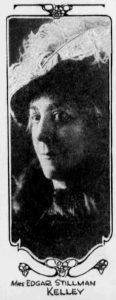
Jan. 5, 1930
An affidavit from Mrs. Stillman Kelley, National President of NFMC (1925-1929) and Alma Morse, National Chairman of Contests, declared Nadine Waters won the Massachusetts state contest, therefore she was able to progress to the finals, where she received a Certificate of Merit. In an article carried in the Pittsburgh Courier, Waters said she was, “glad she had partly broken down some of the (racial) barriers built by the club.” Fighting for her state award and the ability to enter the nationals, she was certain would help Black artists in the future. The Cincinnati Commercial Tribune continued, “the struggle of this local girl has attracted many friends… Mrs. Stillman Kelley, Miss Louise Brooks, patron of Roland Hayes of Boston; John Orth, only living pupil of the great Liszt; Mrs. Talbot (sic) of Dayton (Katherine Houk Talbott, President, and promoter of the Dayton Symphony Association).”
Adieu, Farewell Recital 1929
On September 16, 1929, Waters’ bid adieu in a farewell recital in Memorial Hall. She was leaving to study in Paris in November and would return to the U.S. in November of 1935. The Cincinnati Commercial Tribune review of Waters’ performance tried to identify what she would need to glean from European mentors, “… as far as her voice is concerned… Roberts has little to learn… hers is naturally one of the most ravishingly lovely lyric soprano voices the writer has heard… she uses discretion and skill… sheer tonal beauty,” however, her “diction and interpretation need polish which Europe will give the singer… and confidence will doubtless bring freedom of emotional expression.”
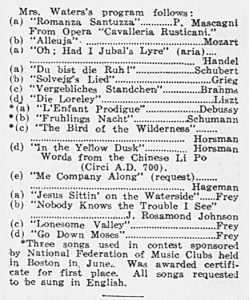
Sept. 15, 1929
Waters’ ‘exceedingly taxing’ program, singing in Italian and German, included the aria from Mascagni Cavalleria Rusticana, Mozart Alleluja, Schubert Du Bist Die Ruh, and Grieg Solvejg’s Lied, then the program reached its peak with Cyril Scott’s Lullaby –– ‘matchlessly sung.’ The three songs she sang at the National Federation of Music Clubs contest are starred in the program as well. She also sang three spirituals, including, Nobody Knows the Trouble I See, by John Rosamond Johnson, NEC student and the famous composer of America’s Black National Anthem, Lift Every Voice. The other two were traditional spirituals, Jesus Sittin’ on the Waterside, Lonesome Valley, and Go Down Moses, by contemporary arranger Hugo Frey.
Paris Debut and Français Diction Award
Waters’ 1930 European debut before an audience of 1,500 was held in Salle d’Iéna, presented by the Revue Internationale de Musique et de Danse and was described glowingly in the press: New York Herald – “tastefully sang with merited success in a voice of clear timbre works by Florence Alyward, Amy Beach, and some spirituals.” Courier Musical – “adorable singer from America, created a wonderful atmosphere when she sang with native beauty and poignant charm a group of American songs. Her success was instantaneous.” La Liberté – “American soprano, made a very successful debut in this city last week. Her voice is remarkable for its quality and flexibility. She sang not only a group of American songs but also several Negro spirituals with finished art and great charm. She was greatly applauded.” Écho de Paris – “Great success … her serious art, coupled with a beautiful voice and personal charm.” Revue International – “this artist possesses a voice of unusual beauty… intelligent interpretation with modesty and unassuming grace.”
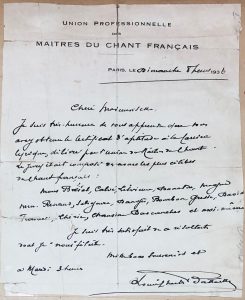
Masters of French Singing,
NRW Scrapbook, Wyoming Historical Society
She had several more recitals around Paris and her London debut in October of 1930 at Grotrian Hall. After a couple of years of living in Paris speaking, singing, and studying music in French, her skills were becoming polished, especially in language and diction. In 1931, she won first place in a vocal diction contest given by the Professional Union of Masters of French Singing (l’Union Professionnelle des Maitres du Chant Français-l’Upmcf) beating out native speakers.
Americans in Paris
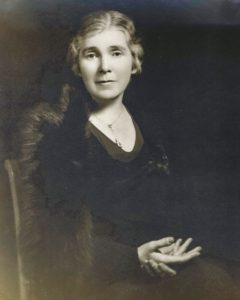
Ursulines of Cincinnati Archives
Many of Waters’ private recitals were encouraged and supported by Americans in Paris. The exchange of talent from Cincinnati to Paris seems to have been due to Margaret Rives Nichols, daughter of Maria Longworth and Col. George Ward Nichols, both pianists and lovers of music, founders of the Cincinnati May Festival and College of Music of Cincinnati. When Margaret married the Marquis de Chambrun in Cincinnati in 1895, they moved to France permanently two years later. On February 21, 1932, before closing their Paris apartment in the heart of Champ de Mars, to head back south to their chateau in the Lozère mountains for the Spring, Marquis Pierre and Marquise Margaret de Chambrun, entertained a crowd of 50 distinguished guests of French and American diplomats and royal society. Also in attendance was their daughter Marthe or Princess Edmund Ruspoli visiting from Rome and Maria Longworth’s niece Countesse Clara Longworth de Chambrun (daughter of Nicholas Longworth II), married to the brother of Marquis Pierre, Count Aldebert de Chambrun. The operatic star of the evening musicale was Nadine Roberts Waters. She sang in a beautiful and spacious high-ceilinged salon, where she delighted everyone singing in French: Fauré Les Berceaux and Clair de lune; Debussy Mandoline and Air de Lia; and Duparc Phidylé. Water’s performance was followed by a Liszt Rhapsody and a Chopin Nocturne by Portuguese pianist José Van Rosenstok. She concluded the program by singing four spirituals. The Enquirer report from abroad was that Waters had, “purity of tones, poetic interpretations, and emotional sincerity… (her) voice moved her audience.”
Waters and famous French cabaret singer, Suzy Solidor, later performed at a fundraising event for an even larger society crowd, in one of the most aristocratic areas in Paris. Members of the French royal family, the Minister of Denmark, the Brazilian Ambassador, and the Chambruns and Ruspolis attended “Les chômeuses de la Rue Fabert,” a dinner to raise money for unemployed women. Waters also sang at the French villa of Miss Gertrude Folger of Boston. While she had three lessons a week with Nadia Boulanger, Gertrude Fogler, MGM speech and voice coach to movie stars such as Katherine Hepburn, Marlon Brando, and Ava Gardner, was so impressed with Waters’ courage to overcome obstacles, she donated her services for free.
Crossing Paths with Marian Anderson in New York City
At Nadine Waters’ return U.S. debut in The Town Hall in New York City on Saturday, February 22, 1936, her French repertoire was applauded. Meanwhile, the career of contralto Marian Anderson was on a similar yet skyrocketing trajectory. In 1936, Marian Anderson also held her debut recital after her return from overseas just two months earlier in the same Manhattan Town Hall. And on that Sunday, February 23, after Waters’ homecoming they sang on the same weekend in New York City with Anderson in the Brooklyn Academy of Music, and Waters at The Town Hall. Newspapers raved about Waters’ debut. She was given nine encores reported the Chicago Defender, and her diction of several languages was exceptional, clear, and pure reported the New York Age. Despite excellent reviews for Waters, the cover of the New York Age gave the headline to Marian Anderson, whose career was in full swing by then. Waters and Anderson sang spirituals by contemporary arrangers, with emotional lyrics that created a new awareness of the past while displaying their virtuosic talent as Black artists facing adversity.
In November of 1944, Waters returned to New York City’s Town Hall, for another successful recital which included Bach, Handel, Schubert, Mozart, Ravel, Brahms, Debussy, Strauss, Schoenberg, Verdi, Amy Aldrich Worth, a Seattle composer known for her scriptural songs, and spirituals arranged by Hall Johnson. Each performance ended with her “careful survey of the most popular Negro spirituals,” stated The New York Age. Manhattan music columnist, Alma Lubin, praised the Cincinnati singer’s ambitious variety of selections sung with “musical intelligence … (with) feeling suited to the numerous styles,” and recognized her studies here in the U.S. and abroad with Boulanger as contributing to her comfort level.
Anderson and Waters in Cincinnati
While Waters was busy in Paris and New York, Anderson came to Cincinnati to sing in several private recitals before singing in Music Hall: in 1929 at Calvary M.E. Church, for an Alpha Phi Alpha Fraternity fundraiser; in 1937 for the Matinee Musicale Club at the Netherlands Plaza; and, in 1938 in the Taft Auditorium. Anderson first appeared on the Cincinnati Music Hall stage for a recital in 1944 and performed Purcell, Scarlatti, Haydn, Schubert, Wagner, and six spirituals, two of which were encores, as well as Comin’ Through the Rye, and Ave Maria for the ‘insistent applause’ reported the Enquirer.
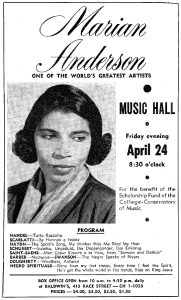
1958-59 CSO Program Book
Anderson’s performance with the Cincinnati Symphony Orchestra-CSO on January 20 and 21, 1952, marked the first time an African American artist appeared with the CSO. She sang Vivaldi, Bach, Delius, and four songs by Brahms. The first local Black soloists to sing with the CSO were soprano Estella Rowe and baritone Wade Mann, singing selections from Gershwin’s Porgy and Bess in March of 1952. When Anderson appeared with the CSO again in 1954, the Enquirer mentioned she sang, for a large crowd, two spirituals as encores after having sung Bach, Haydn, Mahler, Villa-Lobos, and Verdi. Anderson’s last appearance in Music Hall was for a recital benefiting the College-Conservatory of Music in 1959.
Waters’ Return to Music Hall
On Sunday, November 28, 1954, Nadine Waters would appear for her second time as a soloist on the Music Hall stage for the Second Annual Benefit Concert of the Negro Sightless Society of Ohio.* (The year before, the first annual benefit concert at the Taft Auditorium featured local soprano Estella Rowe and Walter Mitchell, baritone, and national stars Cincinnati-born Ronald Isley and Willa Mae Smith.) With Councilman Theodore M. Berry as treasurer, the 1954 concert was to raise money to fund major repairs and updates needed on the home for the blind located at 932 Dayton Street. Leading the concert was George H. Colin, Music Director of the Cincinnati National Association for the Advancement of Colored People-NAACP, with a chorus of 350 singers, representing many Cincinnati church choirs. Singing with Nadine Roberts Waters was another student of Lillian Aldrich Thayer’s, William T. Gee. Professor Gee was a vocal teacher and assistant to Dr. Artie Matthews of the Cosmopolitan School of Music, choir director of the Calvary Baptist Church and Community Choral Club, and a frequent soloist at the June Festival in Eden Park. A review of the second benefit concert, unfortunately has not been found, nor a program from the event. If our readers attended this concert or had friends or family attend and have a program or story to tell, the Friends of Music Hall would be thrilled to listen and digitize materials for our archives.
Nadine Roberts Waters was born in a small Ohio town, into a family of modest means that loved to sing. She worked diligently to fulfill her dreams and broke color barriers along the way while pursuing a career as a concert soprano. She traveled to Paris where she felt accepted and valued as an artist and took lessons with the most distinguished music instructors, meeting and performing with famous composers, singers, and pianists. She built the kind of confidence and virtuosity to sing in world-class concert halls and salons before large crowds in Boston, New York, Paris, and London, as well as dignitaries, socialites, and royalty. She performed frequently with the Pasdeloup Orchestra, Paris’s oldest orchestra, and worked with some of the most esteemed musicians there: Albert Roussel, composer, pianist; Maurice Imbert, pianist, composer; Georges Migot, pianist; and composers Gabriel Grovlez and Henri Tomasi. In 1931, Tomasi dedicated the aria la chanson des sables (The Song of the Sands) from his suite Tam Tam to Nadine Waters, and she sang it in several concerts. She was praised by colleagues like tenor, Louis Charles Battaille, and the legendary Nadia Boulanger in personal letters.
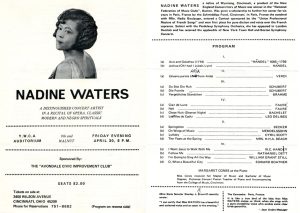
NRW Scrapbook, Wyoming Historical Society
And yet, she still came home, to Cincinnati, to sing in concerts at Memorial Hall, the Isaac M. Wise Center, Taft, Emery, YWCA and YMCA Auditoriums. But also, to pass on her knowledge, wisdom, and tenacity to the next generation of young singers in the Queen City, to ensure that, in the words of Alfred Segal, Cincinnatus, “those whose skins are dark do not wait in vain, and that which they reach for is captured; and so, it came to pass that Nadine Roberts Waters was called to sing in Music Hall.”
Thea Tjepkema, Historian and Archivist, Friends of Music Hall
THANK YOU:
Jennifer A. Sauers, for sharing your wealth of research and love of Nadine Roberts Waters.
I met Nadine Roberts Waters when I was a teenager. I accompanied her on the piano as she sang the National Anthem during the Wyoming (Ohio) Fourth of July celebration. We struck up a friendship, even though we were 70 years apart in age. After we rehearsed in her parlor, she would show me her huge scrapbook stuffed with programs, clippings, and playbills. In 2019 I was surprised to discover her scrapbook at the Wyoming Historical Society. I am in great awe of what she accomplished – particularly amid obstacles she faced, like racial inequality and economic hardship. Her tenacity, determination, and belief in herself inspire me. – Jennifer A. Sauers
Aimée Langrée for friendship and French advice.
Annette Januzzi Wick, Friends of Music Hall board member, for gratefully editing this blog.
Kathy Wade, Friends of Music Hall board member, for encouragement.
*The Negro Sightless Society was founded in 1931 by Jesse D. Locker as the first President. Co-founder George A. Martin became the second President in 1952. From 1941-53, Councilman Jesse D. Locker served 6 terms in the Cincinnati City Council until he was named Ambassador to Liberia by President Dwight D. Eisenhower. The Society would continue to try to repair the home at 932 Dayton until they moved to new quarters in Avondale in 1962.
**Settlement School of Music
Lillian Aldrich Thayer (c.1875-d.March 5, 1939) was born in Cincinnati, moved to Oxford, Ohio, taught for nine years at Oxford College, and had a private studio there (est. 1921). While on the faculty of the Cincinnati Conservatory of Music, she established the Lillian Aldrich Thayer Settlement School of Music with the purpose to, “provide musical education and training for gifted but poor students in every field of music, without regard to race or creed.” Thayer funded the school with her own money and received donations from wealthy Cincinnatians for sponsorships. She was director of the Cincinnati Settlement School of Music from 1923-1938, until moving back to Oxford the year before her death.
Lillian Aldrich Thayer Settlement School of Music began in 1923 in the Wurlitzer Music Store basement, on Fourth Street. Then moved to the first floor of the Burnet House with studios for classes and space for rehearsals, recitals, concerts, and chorus work, with room for an audience of 100. Two other music schools in the city were the Cincinnati Conservatory of Music-CCM and the College of Music of Cincinnati-CMC. CCM and CMC faculty gave recitals along with Thayer’s students at the Settlement School. Mrs. (Jessie) Stillman Kelley from Detroit, President of the National Federation of Music Clubs encouraged Thayer to include her school in the Club membership roster, which helped bring students from across the country and national recognition. Thayer was also emboldened to form branches of her school in Cincinnati by then director of CCM, Bertha Bauer. Branches were at St. Andrew’s Episcopal Church School at Eighth and Mound, a significant cultural center in the West End, and Mt. Zion Methodist Church School, in Walnut Hills. Music teachers were hired from pupils of Thayer’s original downtown central location and graduates of CCM and CMC. Courses were set according to the curricula of the Committee of Standardization of the Music Division of The National Federation of Settlement Schools. Major courses were piano, voice, pipe organ, violin, counterpoint, harmony, history of music, and sight singing. Elective courses were art, chorus, modern languages, literary appreciation, dancing, and dramatics. The school year included four terms of ten weeks each. Board members included Bertha Bauer, Anna Sinton Taft, Rudolph Wurlitzer, Jessie Stillman Kelley, and Florence Foraker Matthews.
WORKS CITED:
Lilian Aldrich Thayer: A Memorial, by Dean Elizabeth Hamilton for the Miami University Bulletin, c.1939.
Alfred Segal, “A Man and His Wife: Story of Devotions, Waters Sings in Music Hall Friday,” The Cincinnati Enquirer, 10-3-1928.
Bob Elkins, “Wyoming to Rename Street for Prominent Civic Leader,” Enquirer, 10-24-1981.
“Recital In Boston,” The Union, 10-14-1922.
“Artists Please in Recital,” The Union, 7-7-1923.
“Song Bird: To Repeat Recital at Wyoming, Lockland, YMCA Wayne Avenue,” The Union, 7-7-1923.
“Recital: The Kenyon Ave. Christian Church,” The Union, 6-16-1923.
“Charming Vocalist,” The Union, 6-30-1923.
“Nadyne Roberts Waters: Farewell Recital,” The Union, 9-2-1923.
“Nadine Waters: Who’s Who in Radio; Captain Austin and Noble Sissle Guests,” The Union, 9-19-1926.
“Will Give Song Recital,” The Cincinnati Post, 6-30-1927.
“WLOE–Boston–11 AM–Nadine Roberts Waters, soprano, Miss Johnson, acc.” The Boston Globe, 1-24-1928.
“Program For Jubilee Set, Music Hall Celebration,” Enquirer, 9-30-1928.
“Kentucky Day” At Exposition,” The Cincinnati Post, 10-6-1928.
“Composer Honored at Jubilee at Music Hall Exposition,” Enquirer, 10-6-1928.
“Nadyne Roberts Waters, Recital, Memorial Hall, Friday, Nov. 23,” Enquirer, 11-11-1928.
“Recital, Memorial Hall, auspices Valley Forge Club,” Enquirer, 11-24-1928.
“Boston Singer Loses in Contest,” The Pittsburgh Courier, 6-22-1929.
“Nadyne Roberts Waters, Nous Allez Club of Wyoming,” Cincinnati Commercial Tribune, 9-15-1929.
“Nadyne Waters in Lovely Voice at Her Recital,” Cincinnati Commercial Tribune, 9-17-1929.
“Progress Being Made in Paris,” Cincinnati Commercial Tribune, 1-5-1930.
“Mme. Waters Makes European Debut,” Paris, France, April 10, The Pittsburgh Courier, 4-12-1930.
“Two Important Receptions on Calendar of Paris – Cincinnati Week,” Enquirer, 2-21-1943.
“Nadine Waters,” The Brooklyn Daily Eagle, 2-24-1936.
“Concert Scheduled, Emery Auditorium,” Enquirer, 4-6-1936.
“Cincinnatian Will Sing in Town Hall: Receives Encore: Tune into WCPO,” The Cincinnati Post, 10-17-1944.
“Nadine Waters Will Appear in Town Hall: Recital, November,” Enquirer, 10-28-1944.
“Nadine Waters Gives Recital,” Enquirer, 11-14-1944
“Nadine Waters Here Tonight: Jewish Center, Wise Center Auditorium,” Enquirer, 1-6-1946.
“Our famous vocalist, Nadyne Roberts Waters, WLW, Zoo Opera Auditions of the Air,” The Union, 3-22-1951.
“Soprano Will Be Soloist for Negro Blind Benefit,” Enquirer, 11-25-1954.
“Colin is Concert Leader for Blind,” The Cincinnati Post, 11-26-1954.
“Obituaries: Nadine Roberts,” Enquirer, 9-11-1985.
